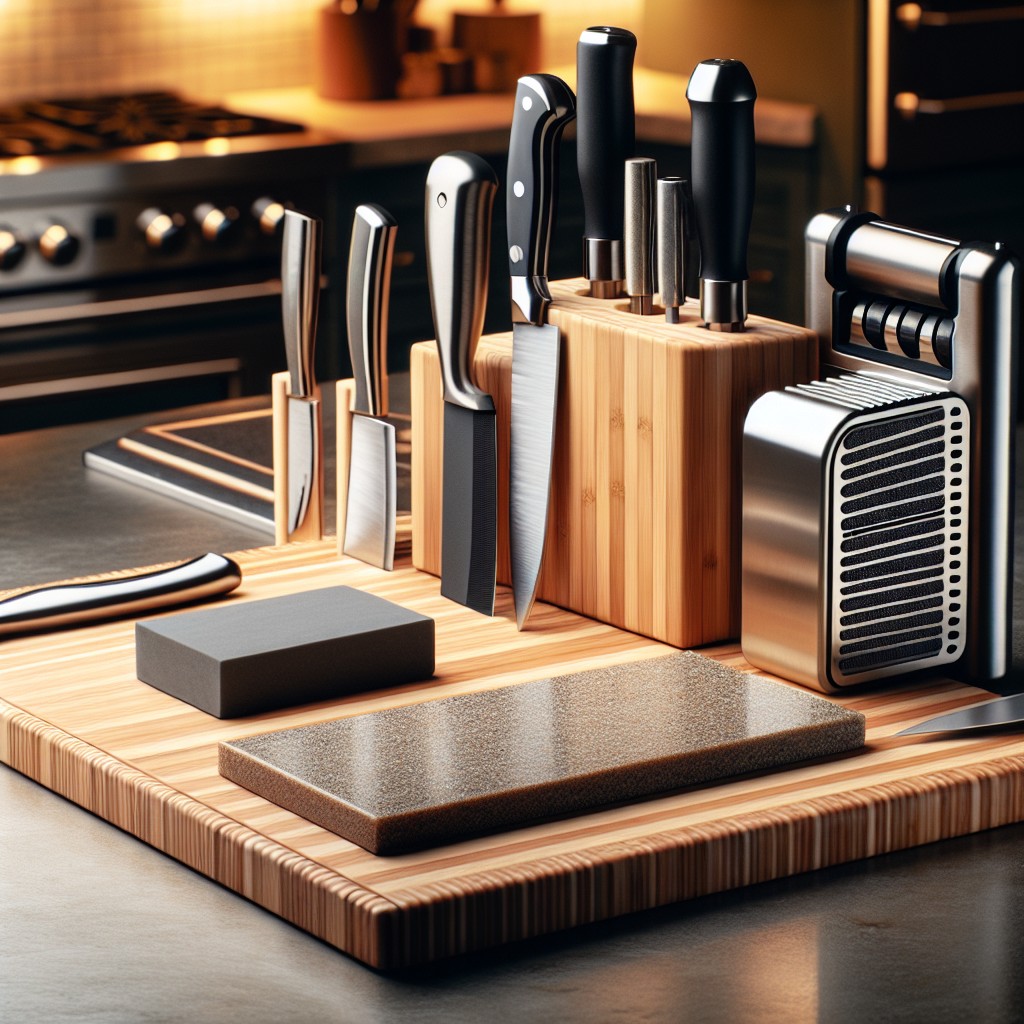Last updated on
Master the craft of sharpening kitchen knives, ensuring the prime functionality and longevity of your culinary tools for peak performance in cooking.
Key takeaways:
- Select the correct sharpening tool: whetstones, pull-through sharpeners, electric sharpeners, honing rods.
- Understand blade angles for sharpening: Western knives (20-22 degrees), Japanese knives (15 degrees).
- Use proper technique for handheld sharpeners: stabilize surface, hold knife, maintain angle, switch slots, clean blade.
- Proper use of a honing steel: hold vertically, slide blade down, repeat motion, wipe blade.
- Tips for knife care between sharpenings: proper storage, hand-wash, use wooden or plastic cutting boards, routine honing.
What's Inside
Selecting the Correct Sharpening Tool

Navigating the variety of sharpening tools can be a cut above the rest in maintaining your kitchen knives’ performance. Whether you’re a professional chef or a home cook, the right tool can make all the difference.
Whetstones: Ideal for precision, whetstones offer multiple grit options. Coarse grits (around 220) reshape and repair edges, while fine grits (1000 or higher) hone the blade to a razor-sharp finish.
Pull-Through Sharpeners: Great for beginners, these devices have preset angles, removing guesswork. Glide the knife through the designated slot a few times for a quick touch-up.
Electric Sharpeners: Quick and consistent, electric models often feature multiple stages for sharpening and honing. They’re perfect for those seeking convenience and are especially handy for processing multiple knives back-to-back.
Honing Rods: Not exactly sharpeners, these tools realign the edge of slightly dull blades, maintaining sharpness between more intensive sharpening sessions. They’re a staple for any kitchen.
Selecting a sharpener comes down to the blade’s material and your comfort level with the tool. Prioritize quality and find one that aligns with the types of knives in your kit. Remember, the best sharpener is one that you’ll use safely and consistently.
Understanding Blade Angles for Sharpening
Blade angle is crucial. It determines sharpness and durability of the edge. Most Western knives have angles between 20 to 22 degrees, ideal for robustness and versatility. In contrast, Japanese knives often feature sharper 15-degree angles, facilitating precision cutting you’d expect in sushi preparation.
Achieving the right angle involves consistency. Picture the blade’s edge as the hour hand of a clock. For a 20-degree angle, the edge should point to 4 o’clock on a right-hand side and 8 o’clock on the left. Visualizing this can help maintain the angle during sharpening.
Remember, angle guides can be a savvy investment. These tools assist in keeping the angle constant, taking out the guessing work, and allowing for a uniform edge along the blade length. They’re especially handy for beginners.
Lastly, exercise caution not to apply too much pressure. Let the sharpener do its job. Applying excessive force can alter the angle and potentially damage the blade. Be patient, and you’ll shape a perfectly angled edge that enhances cutting efficiency and prolongs the life of your knife.
Technique for Using Handheld Sharpeners
Mastering the art of sharpening with a handheld sharpener involves a few key steps:
1. Place the sharpener on a flat, stable surface for safety and control.
2. Hold the knife by the handle and gently pull the blade through the slot, applying consistent, light pressure from the base to the tip. Be sure to read the manufacturer’s guidelines for the number of strokes recommended.
3. Keep the knife at a steady angle, guided by the design of the sharpener. This ensures an even edge.
4. After a few pulls through the coarse slot, switch to the fine slot to polish and refine the blade.
5. Clean the blade with a damp cloth to remove any metal filings after sharpening.
Remember, the goal is to revive the blade’s edge without removing excess metal. It’s a maintenance routine, not a one-time fix.
Proper Use of a Honing Steel
Hold the honing steel vertically, with the tip firmly planted on a stable surface to ensure control. Grip your knife at the correct angle – typically around 15 to 20 degrees for most kitchen knives – and slide the blade down the steel, pulling it towards you, starting from the heel to the tip.
Repeat this motion about five to ten times, alternating sides to maintain an even edge. Keep your motions fluid and consistent to avoid uneven pressure, which can lead to more harm than good on your blade’s edge. Remember, honing doesn’t sharpen; it realigns the edge, which is essential for optimal cutting performance.
Always finish by wiping the blade with a damp cloth to remove any metal shavings before using the knife again.
Tips for Knife Care Between Sharpenings
Maintaining the sharpness of your kitchen knives ensures they’re always ready for action. A little daily care goes a long way.
Primary to preservation is proper storage: use a wooden block or magnetic strip to avoid blunt-inducing contact with other utensils.
The dishwasher is a knife’s adversary, so always hand-wash with a gentle soap to prevent corrosion. After cleaning, dry immediately—moisture is the precursor of rust.
During use, opt for wooden or plastic cutting boards to minimize edge dullness.
Lastly, a routine honing with a steel rod realigns the blade’s edge, keeping it in precise cutting form until the next sharpening session.




